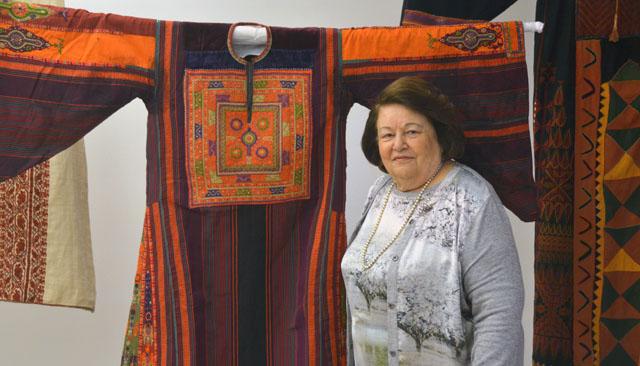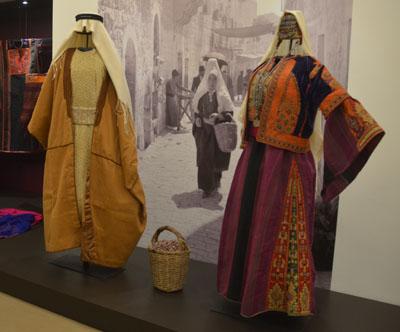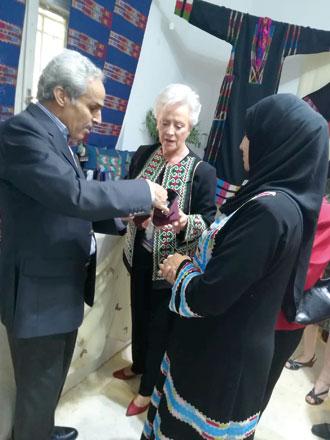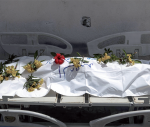You are here
Palestinian heritage lives on in Widad Kawar’s collection of dresses, jewellery
By Muath Freij - Apr 16,2015 - Last updated at Apr 16,2015

AMMAN — When conflict began to flare up in Palestine, Widad Kawar felt the need to safeguard the country’s heritage in any way she could.
She started collecting dresses and jewellery of traditional significance.
Kawar, who recently opened the Widad Kawar Home for Arab Dress, Tiraz to house her collection, said she began gathering traditional dresses from Palestine 40 years ago on a slow scale.
“Later, whatever happened around me — political, social and important events — pushed me to collect more and more in a systematic way,” she said.
The hobby soon became a full-time occupation for Kawar, collecting Palestinian, then Jordanian and Syrian items of significance to heritage.
From her experience as a collector, she could notice the war’s effect on women’s traditional clothing. “They were very well dressed in the villages. They had their colourful dresses and jewellery.”
But after the creation of Israel on Palestinian lands in 1948, the costumes became faded.
“Women did not make new costumes and everything became expensive. Life in refugee camps also led to the mingling of heritage and embroidery patterns and styles that were once specific to each village, so I thought I must go around collecting what is authentic before it was lost forever.”
The process, however, proved far more difficult in practice, as people were not open to selling the dresses they owned because they were no longer available in the market, according to Kawar, who depended on word of mouth to find willing sellers.
She had more luck after the 1967 war, with more people willing to sell, although the dresses had been more than articles of clothing.
They were a way of life.
“Women had to start making their own dresses when they turned 13 or 14,” Kawar told The Jordan Times in a recent interview.
“If the embroidery was good, it meant she was a clever woman. If the embroidery was not good, it meant she was not a good housewife and this was the tradition in Jordan and Syria,” she added.
Kawar recalled that women — rich or poor — must have a good number of costumes.
“There was a day called ‘Market Day’ every week in Palestine, Jordan and Syria. On this day, women put on their best dresses, headdresses and jewellery and went to the market, where they would look at each other’s embroidered costumes and sometimes pick up new patterns.”
Kawar said each area has its own style of colours, fabric and patterns.
Her personal favourite is Bethlehem’s embroidery style, which, she said, has influenced the patterns used in other villages and cities.
“In the past, it used to take women between six months and a year to finish one dress. The cost differed according to the threads as they are usually expensive. It used to be sold for between JD20 and JD50 during the 1960s.”
Kawar settled in Jordan in 1956, where she was also captivated by the different, more modern patterns of traditional Jordanian dresses, adding them to her growing collection.
The founder of Tiraz, which is now home to some 2,000 pieces of traditional clothes and jewellery, said people around her thought in the beginning that collecting dresses was not worthwhile.
“They told me one day they would be sold as old clothes but I knew it was a very special heritage and this heritage is fading away now.”
Kawar said this kind of heritage is now appreciated more, but the younger generation must also learn to appreciate it.
“We are planning to have workshops and get young people to learn about the history of traditional dresses and how to embroider them. It is not easy to make them believe the need for that but we are going do what we can.”
Recognising the value of her collection, the Tulkarm-born Kawar said she is not going to sell any piece.”There is nothing like some of these pieces in all of Palestine anymore. They are priceless.”
Related Articles
An exhibition that opens Sunday will showcase a collection of traditional dresses and jewellery items, in a step to document and revive the region’s heritage, according to organisers.
When Palestinian Maha Saca found out that an exhibition would be held in Amman showcasing the traditional dresses of her hometown, Bethlehem, through the ages, she realised she had to come to Jordan.
AMMAN — HRH Princess Muna on Monday inaugurated an exhibition showcasing dresses, cushions, bags, shawls and abayas carrying the embroidery


















